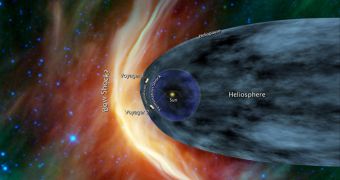Voyager 1 mission controllers at the NASA Jet Propulsion Laboratory (JPL), in Pasadena, California, say that the spacecraft has reached the edge of the solar system. New data from the satellite indicate that the region of space it's currently traveling through is no longer dominated by the Sun.
According to readings provided by some of the detectors on Voyager 1, the intensity of charged particles originating outside the solar system is constantly increasing, suggesting that it has exceeded the boundary of the Sun's sphere of influence.
This is a historic conclusion, as it marks the fulfillment of Voyager's primary mission, to exist the solar system and relay back data on the interstellar medium. Though it is not yet clear whether or not the spacecraft actually exited the solar system, that conclusion is unavoidable.
Voyager 1 is located so far away from Earth that it currently takes 16 hours and 38 minutes for data it emits to cover the 17.8 billion kilometers (11.1 billion miles) separating the two. For comparison, our planet is located around 150 million kilometers (93 million miles) from the Sun.
“The laws of physics say that someday Voyager will become the first human-made object to enter interstellar space, but we still do not know exactly when that someday will be,” Ed Stone explains.
“The latest data indicate that we are clearly in a new region where things are changing more quickly. It is very exciting. We are approaching the solar system's frontier,” adds the expert, a Voyager project scientist at the California Institute of Technology in Pasadena.
NASA is listening to signals from the faraway spacecraft using its Deep Space Network (DSN). Voyager 1 launched to space aboard a Titan IIIE/Centaur delivery system, from Space Launch Complex 41 (SLC-41) at Cape Canaveral Air Force Station, in Florida, on September 5, 1977.
This September, it will mark its 35th anniversary in space. It is currently using its two High Energy telescopes to count the number of charged interstellar particles it collides with. These particles were most likely produced during supernova blasts.
“From January 2009 to January 2012, there had been a gradual increase of about 25 percent in the amount of galactic cosmic rays Voyager was encountering. More recently, we have seen very rapid escalation in that part of the energy spectrum,” Stone explains.
“Beginning on May 7, the cosmic ray hits have increased five percent in a week and nine percent in a month,” he goes on to say, adding that there is no explanation for this other than that Voyager 1 is finally exiting the solar system.

 14 DAY TRIAL //
14 DAY TRIAL //